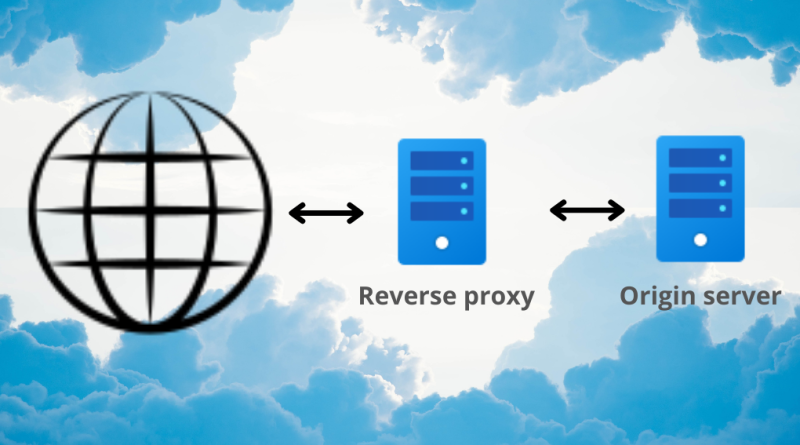What is a Reverse Proxy Server and How Does it Work?
A reverse proxy server is a great way to add an extra layer of security to your web applications. But what is it, and how does it work? In this article, we’ll take a look at what reverse proxies are, how they can help improve security, and some of the most popular reverse proxy servers on the market. So whether you’re looking for a new way to secure your website or just want to learn more about reverse proxies, keep reading!
What is a reverse proxy server?
A reverse proxy server is a type of proxy server that sits between the origin server and the internet. It intercepts traffic from the origin server/backend server and forwards it to the internet. Reverse proxy server acts as a gateway between the origin server and the internet.

Reverse proxies can be used for a number of purposes, but they are most commonly used to improve security. By sitting between your web server and the internet, reverse proxies can filter traffic and block malicious incoming requests before they reach your web server. This can help protect your web server from attack and improve its overall security. Reverse proxies can also be used to improve performance. By caching frequently-requested resources, reverse proxies can reduce the load on your web server and improve its overall performance.
How reverse proxy server works?
Now that we know what reverse proxy is, let’s see how exactly it works. When a client tries to access a website, their request first goes to the reverse proxy server. The reverse proxy server then forwards the request to the origin server. The origin server processes the request and returns the response to the reverse proxy server. The reverse proxy server then forwards the response to the client/user. The above is a very simplistic view of how a reverse proxy server works, but it should give you a general idea of the process.
Reverse Proxy vs Forward Proxy
Let’s take a look at the difference between reverse proxies and forward proxies. As mentioned earlier reverse proxy sits between your web server and the internet (reverse proxy diagram), while forward proxies sit between your web browser and the internet (forward proxy diagram). Reverse proxies can be used to improve security and performance, while forward proxies are primarily used to improve performance. Let’s have a look at some more information below.
Forward Proxy or Proxy
Forward proxy often referred as proxy, is a common fixture on corporate networks. They act as intermediaries between clients and servers, forwarding requests and responses between the two.

As its name suggests, a forward proxy sits in front of client machines and forwards requests to the appropriate servers on behalf of the clients. This can be useful for a variety of purposes such as:
- Enforcing policies: A proxy in the frontend may block any request for content that does not comply with company-wide policies. A forward proxy can enforce content restrictions, ensuring that only legitimate material is accessed. For instance, an organization might have a restriction on which kinds of material may be downloaded or viewed from its network. In this scenario, a forward proxy can be used to deny access to prohibited items by filtering out such requests.
- Improving performance: A forward proxy can improve network performance by caching commonly requested resources and handling client requests. This type of proxy server is often used in business environments to improve the efficiency of the organization’s network.
- Security: Adding a forward proxy to your architecture can improve security in several ways. By inspecting and filtering traffic before it hits your internal network, you can block malicious or unwanted traffic. By hiding the IP addresses of your internal servers from the outside world, you can make it more difficult for attackers to target them.
- Privacy: Forward proxies can also assist with online privacy by hiding client IP addresses from servers. A forward proxy makes it much more difficult for someone to follow you online by rerouting traffic through a server that strips your identifying information. This extra level of anonymity might be the difference between remaining secure and becoming a target of targeted assaults.
- Bypassing restrictions: Proxies can be used to access blocked websites or resources by routing your connection through a server that is not blocked. This can be useful if you are trying to access a website or content that is not available in your country.
Reverse Proxy Example
Let’s say you have a website that is hosted on a single web server. The web server is located in your office, and only your employees have access to it. You want to make the website available to the public, but you don’t want anyone to be able to access your web server directly.
In this case, you could use a reverse proxy server. The reverse proxy server would sit in front of your web server and act as a gateway between your web server and the internet. Any traffic that comes from the internet would first go to the reverse proxy server, which would then forward it to your web server. This would allow you to make your website available to the public without exposing your web server directly to the internet.
Forward Proxy Example
Now let’s say you want to improve the performance of your website. Your web server is located in your office, but you want to cache frequently-requested resources on a server that is closer to the user. In this case, you could use a forward proxy server.
The forward proxy server would sit between your web browser and the internet. When you try to access a website, your request would first go to the forward proxy server. The forward proxy server would then check its cache to see if it has a copy of the requested resource. If it does, it will return the cached copy to you. If it doesn’t, it will fetch the resource from the web server and return it to you.
This would allow you to cache frequently-requested resources on a server that is closer to the user, which would improve the performance of your website.
Popular reverse Proxy Servers
Now that we know what reverse proxies are and how they work, let’s take a look at some of the most popular reverse proxy servers.
- Apache HTTP Server: It’s the most popular web server in the world. It is also one of the most popular reverse proxy servers. The Apache HTTP Server can be used to forward requests to a web server, or it can be used to reverse proxy requests from a web server.
- NGINX: It’s a popular open source reverse proxy server. It is known for its high performance and low resource utilization. It is improving the performance of web servers by caching frequently-requested resources. NGINX can be used to forward requests to a web server, or it can be used to reverse proxy requests from a web server.
- HAProxy: It’s a popular open source load balancer and reverse proxy server. It is often used to improve the performance of web servers by distributing traffic across multiple web servers.
What are Reverse proxies commonly used for?
There are many uses for reverse proxies, but they are commonly used to improve the performance and security of web servers. They can be used to cache frequently-requested resources, which can improve the performance of a web server. Reverse proxies can also be used to filter requests, which can improve the security of a web server. Reverse proxies are also commonly used for global server load balancing, which can improve the performance of a web server by distributing traffic across multiple servers.
Benefits of Using Reverse Proxy Servers
There are many benefits of using reverse proxy servers. Here are just a few:
- Improve security: By sitting in front of your web server and filtering requests, reverse proxy servers can improve the security of your website.
- Improve performance: By caching frequently-requested resources, reverse proxy servers can improve the performance of your website.
- Distribute traffic: By distributing traffic across multiple backend servers, reverse proxy servers can improve the scalability of your website.
- Hide your web server: By hiding your web server from the internet, reverse proxy servers can improve the security of your website.
- Save bandwidth: By caching frequently-requested resources, reverse proxy servers can save bandwidth and improve the performance of your website.



